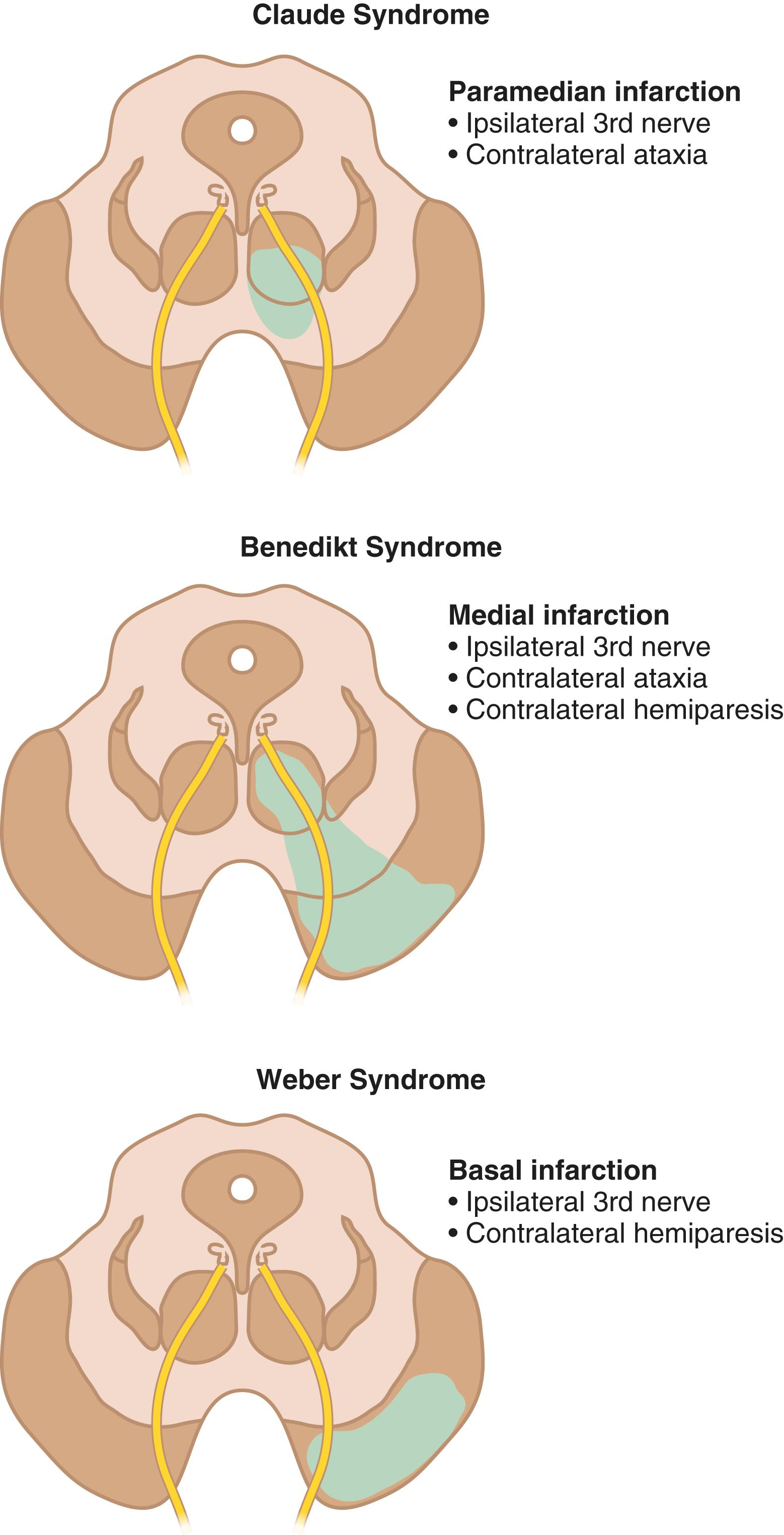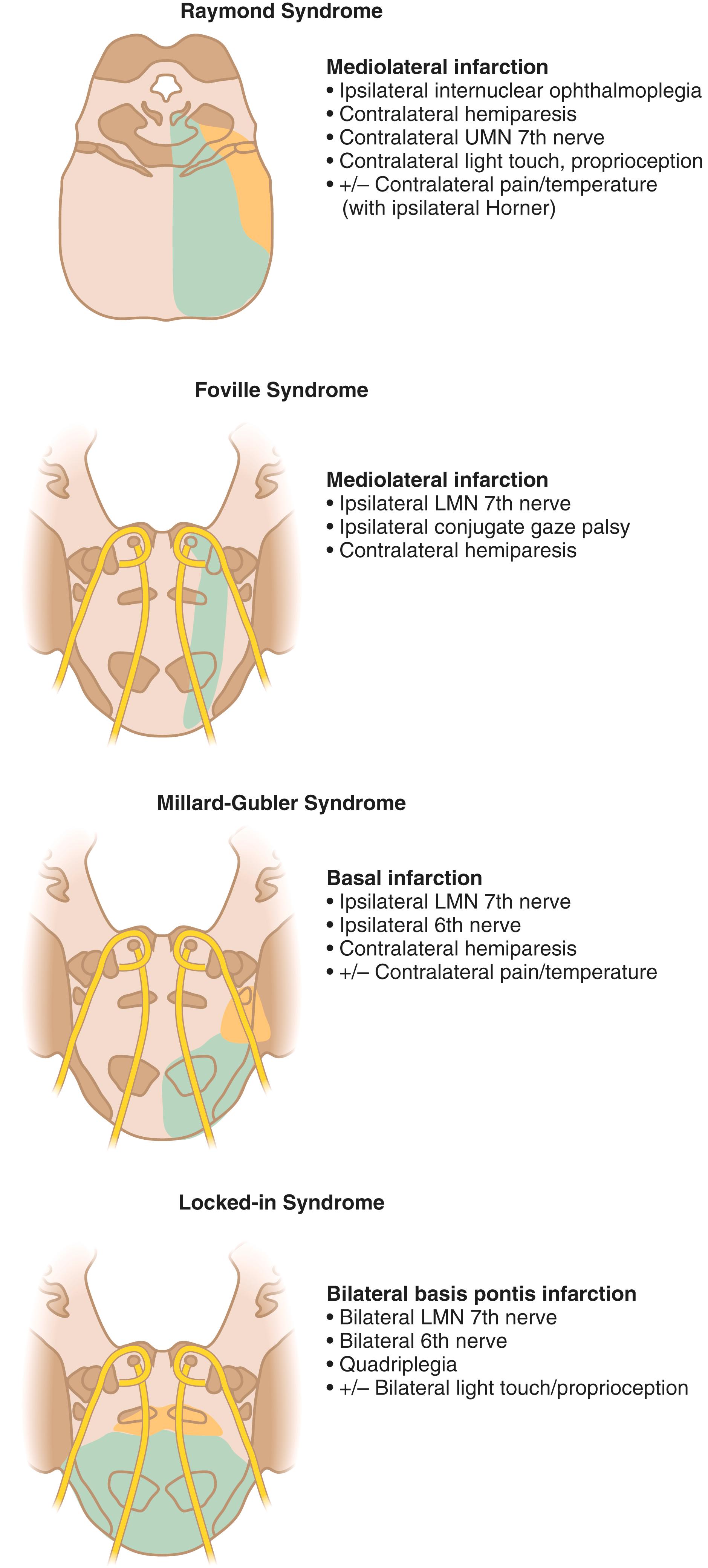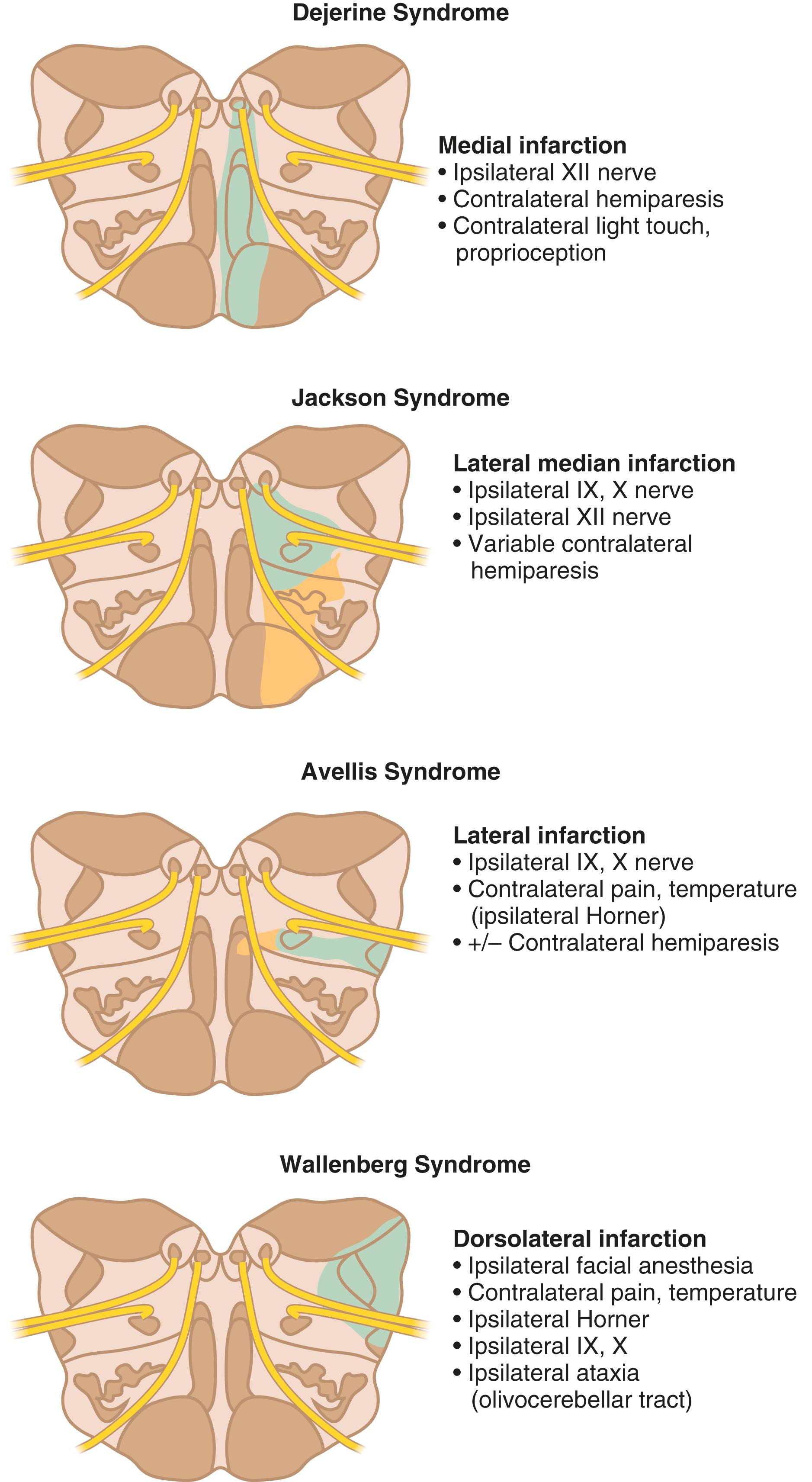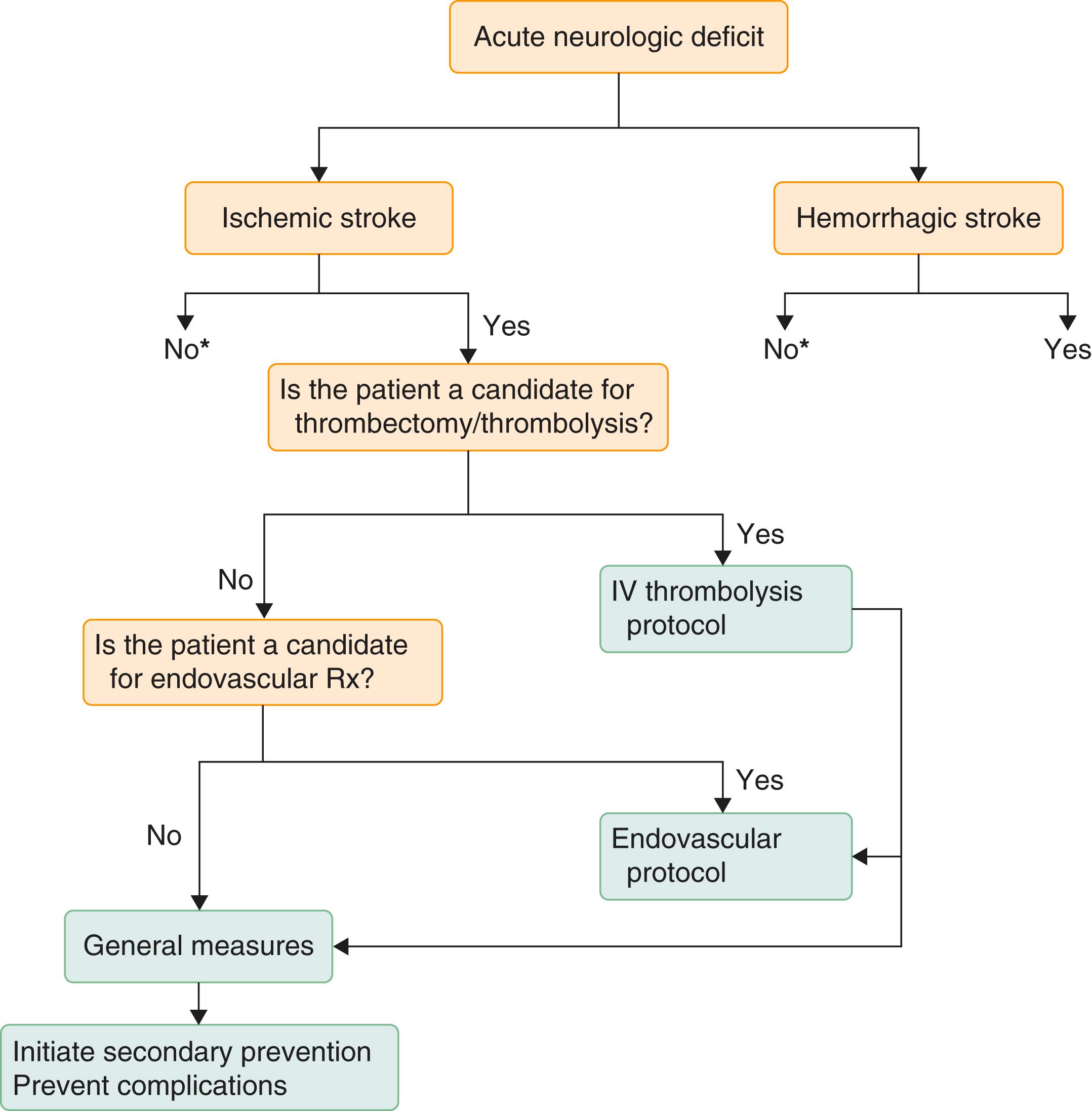Physical Address
304 North Cardinal St.
Dorchester Center, MA 02124
Ischemic cerebrovascular disease is caused by a reduction of blood supply to the brain. The injury may be focal (related to occlusion of a single artery), multifocal (related to occlusion of several arteries), or global. Although certain clinical features (e.g., severe hypertension, headache, impaired consciousness) may suggest brain hemorrhage ( Chapter 377 ) rather than ischemia, it is not possible to differentiate the two types of conditions without a brain imaging study. In the absence of an inflammatory disease such as vasculitis or other rare conditions, simultaneous involvement of more than one vascular distribution suggests a proximal source of embolism (i.e., a cardiogenic or a proximal arterial source). Involvement of a single vascular territory may be due to either local steno-occlusive disease (e.g., atherosclerosis) or a proximal source of embolism. Involvement in the distribution of a single penetrating artery suggests small-vessel type intracranial disease, but ischemic strokes in this distribution may also be caused by proximal arterial steno-occlusive disease or embolism.
The definition of ischemic stroke is brain, spinal cord, or retinal cell death attributable to ischemia with neuropathologic, neuroimaging, or clinical evidence of permanent injury. Overall, approximately 85% of strokes are related to ischemic disease, with 44% attributable to atherosclerosis, 21% to cardiogenic embolism, and 20% to small-vessel disease.
Transient ischemic attack (TIA) is defined as a brief episode of neurologic dysfunction resulting from focal cerebral ischemia with no evidence of corresponding tissue injury. Symptoms are similar to those of ischemic stroke. Previously characterized as a transient deficit with symptoms persisting for less than 24 hours, evidence of corresponding tissue injury can be found on brain magnetic resonance imaging (MRI) in 30 to 40% of patients who otherwise fulfill the clinical definition of TIA.
Stroke (ischemic and hemorrhagic) is the third leading cause of death worldwide and the fifth leading cause of death in the United States. It is also a leading cause of adult disability. In addition to age, race or ethnicity, and family history, certain lifestyle factors and medical conditions increase the risk of stroke ( Chapter 375 ; Table 376-1 ). Of these, hypertension is the single most important treatable risk factor ( Chapter 64 ; Table 376-1 ), and the risk of stroke increases with increasing blood pressure without a threshold effect. Diabetes ( Chapter 210 ) is associated with a doubling of the risk of stroke ( Table 376-1 ). Atrial fibrillation ( Chapter 52 ; Table 376-1 ) is associated with up to 25% of ischemic strokes, with the absolute risk varying by concomitant risk factors.
| FACTOR | POPULATION-ATTRIBUTABLE RISK | RISK REDUCTION WITH TREATMENT |
|---|---|---|
| LIFESTYLE | ||
| Cigarette smoking | 12-14% | 50% within 1 yr of quitting |
| Physical inactivity | 30% | None proven |
| Excess alcohol consumption | 7% | None proven |
| MEDICAL | ||
| Hypertension | >90% | 32% |
| Diabetes | 5-27% | None proven |
| Atrial fibrillation | 2-24% | 64% |
| Carotid stenosis | 2-7% | 50% |
| Sickle cell disease | — | 91% with transfusion therapy in children |
Extracranial carotid artery stenosis is found in 5 to 10% of individuals older than 65 years and is associated with about 10% of all ischemic strokes. Untreated asymptomatic carotid stenosis carries only a 1 to 2% annual risk of stroke, and the risk is decreased to as low as 0.5% annually with standard medical therapy. Stroke is also a complication of sickle cell disease ( Chapter 149 ), although this risk is dramatically reduced by transfusion therapy in high-risk children. Unlike with coronary heart disease, the overall association between high cholesterol concentration and the risk of stroke is less certain. In the general population, the risk of ischemic stroke is associated with higher levels of total and low-density lipoprotein cholesterol, whereas the risk of hemorrhagic stroke has been associated with lower levels.
Other factors associated with the risk of stroke include migraine headaches with aura ( Chapter 367 ), particularly in women who smoke and are receiving oral contraceptives; elevated homocysteine level; high lipoprotein (a) level; postmenopausal hormone replacement therapy ( Chapter 222 ); coagulation disorders ( Chapter 67 ); systemic infection ( Chapter 61 ); renal impairment ( Chapter 116 ); low vitamin D levels ( Chapters 199 and 226 ); and environmental factors, including air pollution.
For patients who have a TIA and who are by definition at increased risk of having an ischemic stroke during the next few days or weeks or those who had an ischemic stroke, distinguishing among the major pathophysiologic causes (i.e., atherothrombotic, cardioembolic, small vessel) is critical to guide secondary prevention. Atherothrombosis due to atherosclerosis is the most common cause of a TIA or stroke that is related to steno-occlusive disease in the distribution of a single artery. The ischemia may be caused when progressive stenosis at the site of an atherosclerotic plaque leads to hemodynamic compromise affecting distal brain tissue. Sometimes bleeding into the plaque can lead to abrupt arterial occlusion, and sometimes a thrombus that has formed on an ulcerated plaque may embolize and occlude a distal artery. Occlusion of a cerebral artery, however, does not necessarily lead to ischemic brain injury. Blood may still reach the supplied territory through collaterals, either through the circle of Willis or from extracranial-intracranial anastomoses (see E-Fig. 375-1 in Chapter 375 ).
Arterial dissection is now recognized frequently on the basis of noninvasive vascular imaging such as MR angiography or computed tomography (CT) angiography. Other arteriopathies, such as fibromuscular dysplasia ( Chapters 64 , 66 , and 110 ), may also lead to single, large-vessel distribution, ischemic stroke. Atherosclerosis of the ascending aorta or aortic arch can lead to the formation of thrombus, which can then embolize to a cerebral artery.
Atrial fibrillation is the single most common cause of cardioembolic stroke, with annual risks of 3 to 5% if it is not treated with anticoagulation but declining to about one fourth of that risk with anticoagulation ( Chapter 52 ). Other cardiac causes of cerebral embolism include clots or vegetations in patients with valvular heart disease ( Chapter 60 ), such as mechanical prosthetic heart valves ( Chapter 60 ), infectious endocarditis ( Chapter 61 ), nonbacterial endocarditis ( Chapter 61 ); and mural thrombi in patients with a cardiomyopathy ( Chapter 47 ) or myocardial infarction (MI), particularly anteroseptal MI ( Chapter 58 ). Paradoxical embolism of a venous clot across a congenital heart defect, such as a patent foramen ovale or an atrial septal defect ( Chapter 55 ), is another cause of embolic stroke. Intracranial atherosclerotic plaque in a nonstenotic artery can also be a source of embolic stroke.
Small-vessel intracranial disease may result in ischemic stroke in the distribution of a single penetrating vessel. These strokes commonly affect deep structures (e.g., centrum semiovale, basal ganglia, thalamus, internal capsule, pons) and occur more frequently in patients with hypertension and diabetes. Classically, small-vessel strokes are caused by lipohyalinosis, which is a thickening of the vessel wall resulting in a diminished luminal area, but they also can be caused by atherothrombosis or embolism.
Symptoms of ischemic stroke may worsen during the first hours or days through various mechanisms. For example, decreases in systemic blood pressure may decrease cerebral blood flow to marginally perfused, ischemic brain. In the setting of atherothrombotic disease, a partially occluded artery may progress to complete occlusion. Recurrent embolism may occur from a proximal arterial or cardiac source. Cerebral edema may develop during the first few days after an ischemic stroke, and the resulting mass effect can lead to clinical deterioration ( Chapter 375 ). Secondary bleeding can occur in an area that was primarily the site of an ischemic injury when reperfusion, either through collateral vessels or as the result of a therapeutic intervention, restores blood flow into vessels in which the endothelium was damaged by the original ischemic insult.
Neurologic deficits that occur in the setting of ischemic stroke depend on the involved vascular territory ( Table 376-2 ) and underlying cause. Embolic stroke is generally characterized by the presence of a maximal deficit at onset, whereas the onset may be more gradual or stuttering in the setting of an atherothrombotic stroke. The distinction, however, is not of great use for diagnosis in individual patients. Transient symptoms in the same distribution can be caused by TIA if there is no permanent tissue injury.
| OCCLUDED ARTERY | TYPICAL MAJOR CLINICAL MANIFESTATIONS ∗ |
|---|---|
| Internal carotid artery | Loss of vision in the ipsilateral eye Ipsilateral middle cerebral artery syndrome |
| Anterior choroidal artery | Contralateral hemiparesis Contralateral sensory impairment Contralateral visual field defect |
| Anterior cerebral artery | Contralateral leg > arm paresis Contralateral leg > arm sensory deficit |
| Middle cerebral artery | Contralateral hemiparesis affecting face and arm > leg Contralateral sensory deficit affecting face and arm > leg Contralateral visual field defect Aphasia (dominant hemisphere) Contralateral hemispatial neglect (nondominant or dominant hemisphere) |
| Posterior cerebral artery | Contralateral homonymous hemianopia (or homonymous superior or inferior quadrantanopia) Contralateral sensory deficits (thalamic involvement) |
| Basilar artery tip | Bilateral central visual loss Confusion |
| Basilar artery | Ipsilateral cranial nerve deficit Contralateral hemiparesis Contralateral sensory impairment affecting arm and/or leg Coordination deficit |
| Vertebral artery, posterior inferior cerebellar artery | Ipsilateral sensory impairment over the face Dysphagia Ipsilateral Horner syndrome Ataxia |
| Superior cerebellar artery | Gait ataxia Ipsilateral limb ataxia Variable contralateral limb weakness |
The bifurcation of the common carotid artery into the internal and external carotid arteries in the neck is a common site of atherosclerotic disease (see Fig. 375-1 in Chapter 375 ). With occlusion of the internal carotid artery, patients who have an incomplete circle of Willis can have a profound contralateral loss of motor and sensory function affecting the face, arm, and leg. In patients with an intact anterior communicating artery that can supply the ipsilateral anterior cerebral artery (see Fig. 375-2 in Chapter 375 ), the leg may be relatively spared, and an internal carotid artery occlusion may be clinically indistinguishable from a middle cerebral artery occlusion. If the A1 segment of the anterior cerebral artery is absent on the side opposite an internal carotid artery occlusion in a patient with an intact anterior communicating artery, the ipsilateral leg may also be affected, and the presentation may be confused with a cardioembolic cause because both hemispheres are involved. Occlusion of the ipsilateral ophthalmic artery can lead to blindness in that eye. Transient symptoms of retinal ischemia, classically described by patients as a “shade coming down over my vision,” indicate amaurosis fugax. Other common symptoms of transient monocular visual loss include a darkening or blurring of vision in the affected eye. Transient hypoperfusion ipsilateral to a high-grade internal carotid artery stenosis can cause limb-shaking TIAs that can be confused with seizures. Systemic hypotension in the setting of a high-grade carotid stenosis can lead to ischemic injury in watershed zones between the major intracranial arteries and in the border zone between the distal territories of cortical and lenticulostriate penetrating vessels ( Chapter 375 ).
The anterior choroidal artery generally arises from the supraclinoid portion of the internal carotid artery. Causes of occlusion of the anterior choroidal artery are similar to those of occlusion of the small intracranial arteries. Symptoms can include contralateral motor and sensory deficits and contralateral visual field deficits, the latter of which can occur in isolation.
About 2% of strokes are related to isolated occlusion of the anterior cerebral artery (see Figs. 375-6 and 375-7 in Chapter 375 ). Occlusion of the A1 segment in patients in whom the contralateral A1 segment is hypoplastic or absent can lead to bilateral leg involvement, abulia, and urinary incontinence because of infarction of both frontal lobes.
The middle cerebral artery is the most common artery involved in occlusions related to cardiogenic embolism. It supplies the lateral portions of the frontal, parietal, and temporal lobes as well as the basal ganglia and the anterior limb and genu of the internal capsule. Middle cerebral artery occlusions are characterized by involvement of the contralateral face and arm to a greater extent than of the leg (see Figs. 375-6 , 375-7 , and 375-8 in Chapter 375 ), often accompanied by a contralateral hemispatial neglect. When the dominant hemisphere is involved, the patient may have an aphasia. With frontal lobe involvement, patients often have an ipsilateral conjugate deviation of the eyes, which can be forced past the midline with vigorous encouragement, oculocephalic maneuvers, or caloric stimulation.
Branch middle cerebral artery occlusions can result in partial syndromes. For example, a branch middle cerebral artery occlusion with intact collaterals can cause a global aphasia without an accompanying motor deficit (i.e., “global aphasia without hemiparesis”). Anterior branch dominant hemisphere middle cerebral artery occlusions can cause an expressive cortical-type motor (Broca) aphasia with sparing of comprehension. Occlusion of the angular branch of the middle cerebral artery can cause receptive cortical-type (Wernicke) aphasia. Border zone infarcts can result in transcortical aphasias, characterized by relatively preserved repetitions.
Both posterior cerebral arteries arise from the basilar artery in about 75% of people (see Fig. 375-3 in Chapter 375 ). In the other 25%, one or both P1 segments are hypoplastic or absent, with the posterior cerebral arteries arising from the ipsilateral internal carotid artery (so-called fetal circulation). Without vascular imaging, it is not possible to determine if a posterior cerebral artery distribution infarct (see Figs. 375-6 to 375-8 in Chapter 375 ) is related to carotid or vertebrobasilar circulation disease. The posterior cerebral artery and posterior communicating arteries supply the thalamus. Thalamic infarctions can result in contralateral hemianesthesia and ataxia. Contralateral hemiballismus can result if the subthalamic nucleus is damaged. Infarction of the ipsilateral occipital lobe causes a contralateral homonymous hemianopia that can be partial, depending on the extent of injury. The visual field deficit tends to become more congruous in the two eyes as the area of injury becomes more posterior (i.e., the closer to the occipital pole).
Occlusion of the basilar artery (see Figs. 375-3 and 375-4B in Chapter 375 ) can lead to “locked-in syndrome” ( Chapter 373 ) in which the patient is awake and alert, because the periaqueductal gray can receive a separate blood supply, but is unable to move or to communicate except for vertical eye movements, because of sparing of the collicular nuclei in the midbrain. The top of the basilar artery is a common location for embolic occlusion. Symptoms can include visual field defects due to unilateral or bilateral occipital injury and confusional states due to thalamic involvement.
Occlusions of penetrating and circumferential branches of the basilar artery and vertebral artery can produce a variety of symptoms (see Table 376-2 ) depending on the portion of the artery involved, several of which constitute eponymic midbrain ( E-Fig. 376-1 ), pontine ( E-Fig. 376-2 ), or medullary ( E-Fig. 376-3 ) syndromes. Occlusion of the superior cerebellar artery can cause truncal ataxia because of infarction of the cerebellar vermis, with or without ataxia of the ipsilateral limbs, which can be caused by infarction of the ipsilateral cerebellar hemisphere.



Occlusion of a small penetrating intracranial vessel can result in one of the classic lacunar syndromes ( Table 376-3 ). These syndromes are not otherwise localizing and can occur with occlusions of small penetrating vessels in either the anterior or vertebrobasilar circulations. Lacunar syndromes are not pathognomonic of small-vessel intracranial disease and can be caused by a variety of other conditions, including emboli from a more proximal arterial or cardiac source or a brain hemorrhage ( Chapter 377 ).
| Pure motor stroke Pure sensory stroke Ataxic hemiparesis Clumsy hand–dysarthria |
The diagnosis of ischemic stroke depends on acquiring an accurate history, eliciting key findings on general and neurologic examinations, and obtaining supporting data from selected laboratory studies ( Fig. 376-1 ). An initial anatomic and pathophysiologic differential diagnosis is usually established based on the patient’s history. Findings on physical and neurologic examinations can support or refute initial conclusions based on the history and can further refine the differential diagnosis.

The abrupt onset of a focal neurologic deficit in the distribution of a specific vascular territory is the hallmark of acute ischemic stroke. The differential and most likely diagnosis can often be determined on the basis of history alone. For example, a patient with a history of atrial fibrillation who abruptly develops word-finding difficulties associated with a right hemiparesis and sensory impairment most likely had a cardiogenic embolus to the left middle cerebral artery. A patient with the acute onset of diplopia, vertigo, and a hemiparesis most likely has a lesion in the brain stem.
Goals of the immediate history include determining the time when symptoms began or the last time the patient was known to be well, concomitant medical illnesses, risk factors, medications, allergies, and other potential causes for symptoms that might mimic acute stroke. Because a stroke may affect a patient’s ability to communicate, the history may require input from a witness. Additional details of the patient’s past medical, family, and social history may need to be deferred in the emergent setting, but these issues can be explored if the information is important for acute treatment decisions.
Severely elevated blood pressures in the setting of neurologic deficits referable to the basal ganglia, thalamus, pons, or cerebellum increase the likelihood of a brain hemorrhage ( Chapter 377 ). In a patient with transient vertigo associated with left arm movement, a reduced blood pressure in that arm suggests subclavian steal syndrome. Detection of an anterior cervical bruit contralateral to symptoms and signs indicative of a middle cerebral artery distribution infarct increase the likelihood of symptomatic carotid stenosis. An irregularly irregular heart rhythm with or without a cardiac murmur may indicate atrial fibrillation and a cardioembolic etiology. Finding a cholesterol embolus on funduscopic examination can be consistent with a proximal source of atheroembolism. Funduscopy can also show evidence of a small-vessel disease related to diabetes or hypertension (see Figs. 391-22 and 391-24 in Chapter 391 ).
A general neurologic examination ( Chapter 366 ) including evaluations of cognition, language, spatial neglect, cranial nerves, motor function, sensation, coordination, gait, and reflexes is important both for documenting stroke-related deficits and for providing information critical for determining the area of the brain affected by the stroke and the extent of the injury. The use of a standardized graded neurologic impairment assessment provides a tool for measuring the severity of the stroke, determining the risks and benefits of treatment interventions, assessing prognosis, and observing patients objectively over time. The National Institutes of Health Stroke Scale, which is the most commonly used approach, is both reliable and well validated. The individual items are summed to provide a total score.
Become a Clinical Tree membership for Full access and enjoy Unlimited articles
If you are a member. Log in here